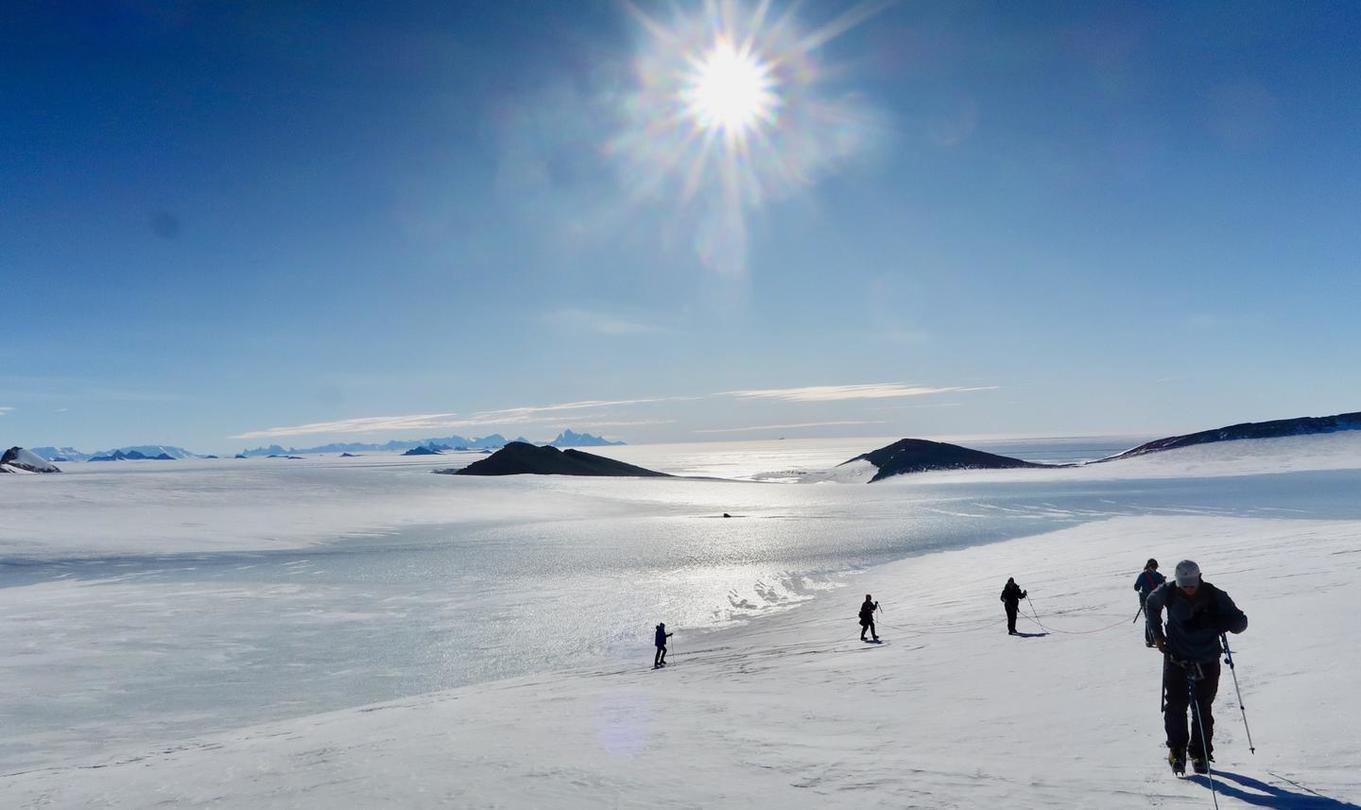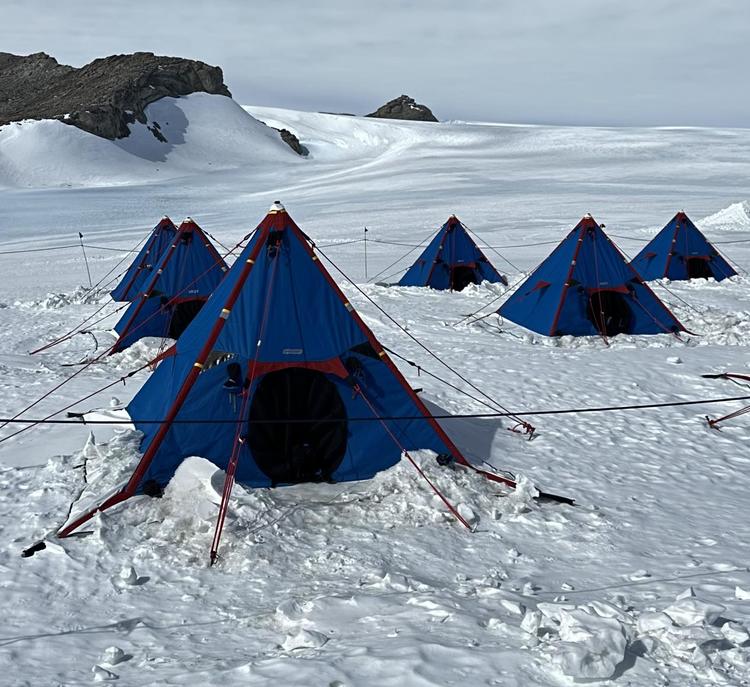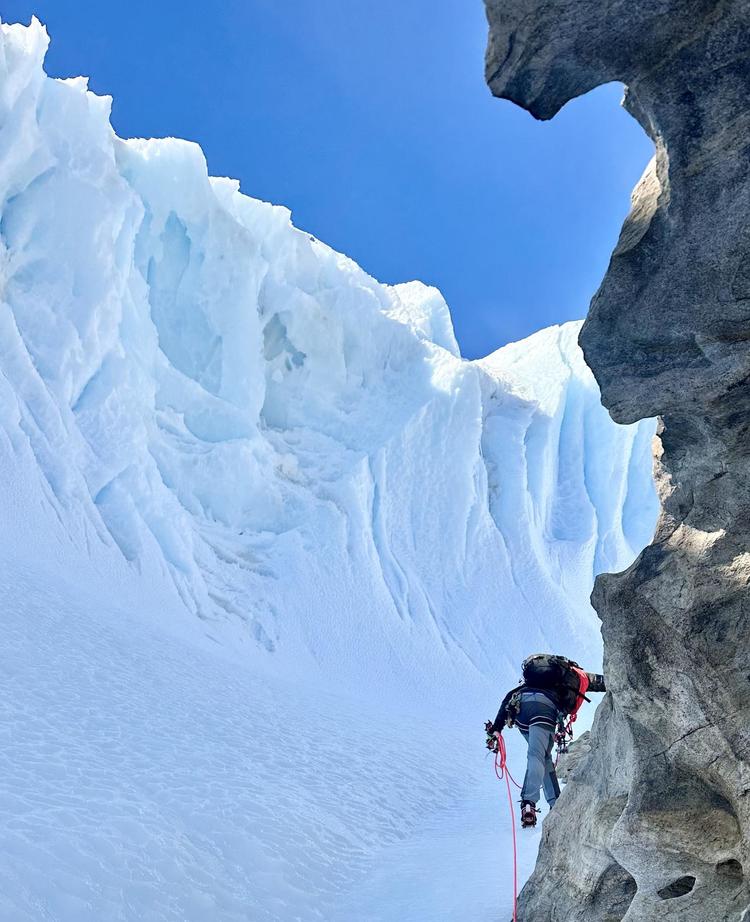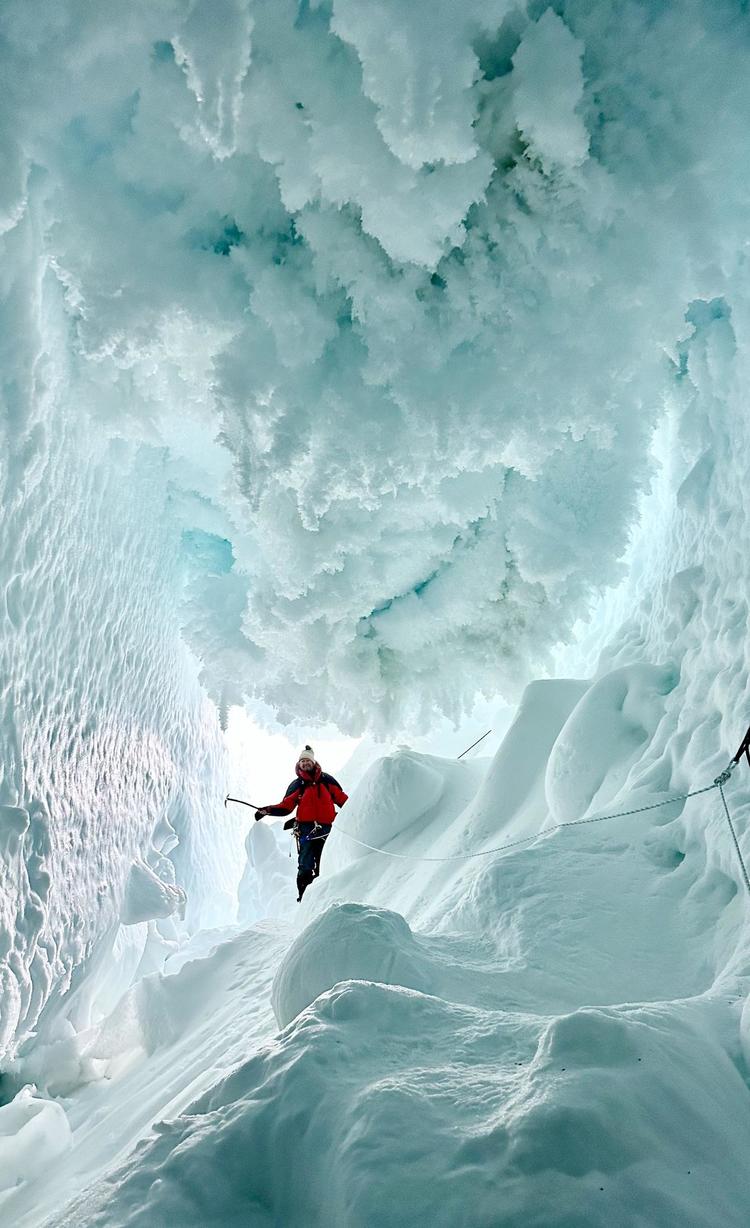Grace Cordsen ’19: From Art & Archaeology to Polar Explorer

Grace Cordsen ’19 woke up in her polar pyramid tent on the first day of 2024 after ringing in the new year at Wolf’s Fang Runway ice bar in the bright aura of the midnight sun at the Southern end of the world.
Currently working with White Desert as one of the youngest women to serve as the manager of an Antarctic camp, Cordsen has been working in the polar expedition industry and researching topics on these regions since graduating with a B.A. in art history and a certificate in archaeology.
Her interest in the polar regions began her junior year at Princeton when she earned an Adventure Canada and Explorers Club research grant aboard a ship that sailed through the North Atlantic Ocean.
Looking to explore the world before committing to a job, after graduation, Cordsen worked as Adventure Canada’s Researcher in Residence in the Arctic and continued as a staff member in Newfoundland. From there, she worked on a Polar Latitudes Antarctic ship and launched her own guide company that produced U.S. travel guides.
In 2022, Cordsen did circle back to a more conventional career path temporarily. “I caved,” she said, “and took a stab at the more corporate job that I thought I would go into when I graduated.” She spent a year and a half working for Google while still feeding her passion for the polar regions. She helped plan an expedition to Arctic Norway, worked as a freelance content creator for Arctic brands, and worked in part-time remote roles for Antarctic companies.
In May 2023, Cordsen left Google and returned to the polar regions, working on tourist expeditions as a program director, educational coordinator, and freelance journalist and conducting research for independent projects.
“The clear climate impact that both regions are facing is this notable and visible change that has made me so motivated to get involved in these regions.”
She is drawn to each of the polar regions for different reasons. “For the Arctic, it’s the combination of culture, wilderness, and history,” she said. “For the Antarctic, it’s simply the awe of nature and the expansiveness of the earth.” Her passion for both regions propelled Cordsen to take an active role in protecting them. “The clear climate impact that both regions are facing is this notable and visible change that has made me so motivated to get involved in these regions,” she said. “I have not felt this way about anywhere else I have visited.”
 Grace Cordsen’s camp accommodations (Photo/Grace Cordsen)
Grace Cordsen’s camp accommodations (Photo/Grace Cordsen)
As Camp Manager, Cordsen leads a team of 13. “My favorite part of my work is certainly my team and the places that we get to go together. It is addicting being part of a small team that works remarkably well together. Put that in one of the most mind-blowing environments in the world, and it is hard not to see why we all love our work.”
Cordsen’s day begins and ends in her tent. The small space, not quite tall enough to accommodate her 5′10″ frame standing up, is her only private space. “I find the tents so comfy,” she said. “Most nights, I take two hot water bottles with me to bed for extra warmth, but I always end up kicking them out of my sleeping bag because I get too hot.”
Showers are limited to roughly one per week, so her mornings typically begin at 7:00 a.m. when she heads for the shared sink in the mess tent. She meets with her team to discuss the day’s schedule before joining the dozen or so guests who come for a week at a time.
Before and after lunch, the group takes excursions like hiking, ice climbing, or abseiling in the stunning scenery. The two highlights are visits to the South Pole and to see a colony of Emperor penguins.
“The Antarctic is known for its wildly unpredictable weather so at any point our plans could get canceled, we could get caught in a storm, or the winds could pick up to almost unimaginable speeds.”
The challenges of living and working in this far-flung region center on the elements. “We get a lot of curve balls thrown into our plans,” said Cordsen. “The Antarctic is known for its wildly unpredictable weather, so at any point, our plans could get canceled, we could get caught in a storm, or the winds could pick up to almost unimaginable speeds.”
Both of the main attractions can only be reached by plane, and seizing safe flight conditions can mean shifting departure from the on-ice airstrip to any hour of the day; it’s not unusual for Cordsen to meet flights between 2:00 a.m. and 6:00 a.m. since that’s the coldest part of the day when the airstrip is as solid as possible. “The hardest part of my current job is certainly the minimal sleep hours and 24-hour sunlight. You never get used to it,” she said. “When I’m here, I’m on 24/7.”
 Hiking in the Antarctic interior, January 2024 (Photo courtesy of Grace Cordsen)
Hiking in the Antarctic interior, January 2024 (Photo courtesy of Grace Cordsen)
What does she miss most about home? “Good coffee.” She’s in frequent contact with friends and family via WhatsApp, so the remote location doesn’t feel too isolating. “And I’m always surrounded by an incredible team,” she points out, “I have a community here.” “I miss good coffee and being able to go for a walk when you want in a t-shirt and shorts,” she said. “Everything here is a little bit of an effort. I miss the relaxing parts of being home.”
When she began her current role in mid-December, Cordsen had already spent two months aboard a ship sailing around the Antarctic Peninsula and two months in the Arctic so that, excepting four weeks at home between the two poles, she’s spent half a year at one or the other. When asked how long she sees herself staying in this environment, she laughs, saying, “Six months of the year is definitely nearing my limit!”
Cordsen knows finding months at a time to experience these regions will become more difficult as she progresses along her career path, so she’s maximizing this opportunity. “When I signed these contracts, I knew that this was going to be a pivotal point where I wanted to get in-the-field work because I have the luxury to have this much time.”
Next year, she’ll begin a graduate program in environmental management. As businesses continue to grow in the polar regions, Cordsen says, “I feel uniquely positioned to make sure the impact is kept to a minimum.”
Cordsen also has two independent research projects underway. The first she developed with Professor Rachael DeLue, which evaluates the visual and written historical records of areas of the Arctic, such as Northeast Greenland and Svalbard, to represent both the drastic environmental changes as well as the overall shifts in perception these regions have experienced. “The research, which will include a visual timeline of these regions, will focus particularly on climate change and how it has been represented in art,” Cordsen explained.
 Climbing in a crevasse in the Antarctic interior (Photo/Grace Cordsen)
Climbing in a crevasse in the Antarctic interior (Photo/Grace Cordsen)
Separately, she is also studying provocative murals of women hand-painted on the walls of the old British scientific station, Port Lockroy, in the Antarctic.
“I think these works of art are amazing specimens of how human needs are literally satisfied by the creation of art,” she said. “I can’t wait to unpack it more. I love that these paintings are some of the only artworks that were not only created in the Antarctic but permanently hang in the region as well.”
Cordsen frequently refers back to her undergraduate experience in her work. “Professor Rachael DeLue’s approach to art, which straddles countless fields and media, opened my eyes to how art history could be applied to anything and how—in many ways—everything is art,” she said. “Being able to analyze anything through the lens of art history has proven to be an invaluable skill to me throughout my career, but particularly in any written work I do on the polar regions,” she said. “These places are best understood through visuals - whether photography, video, or artworks. Because I approach even my scientific writing first and foremost from this visual perspective, I have been able to craft much fuller narratives for these regions and hopefully ignite far greater impact.”
“Because art history crosses over into so many arenas you never know where it might take you. Majoring in art history is an open invitation to explore and to discover what makes you excited to learn.”
Cordsen’s advice for choosing a career path is “Find your niche. Push the limits of what you think can be a career and hone in on exactly what you are passionate about.” Living proof of the efficacy of that approach, Cordsen says, “There are literally thousands of highlights that have all been because of this wacky career path. To name a few, through work, I have been able to experience an immense diversity of Arctic and Antarctic wildlife, visit the South Pole, snorkel with Arctic Orca in Norway, ski in the Antarctic, and become close with countless indigenous people.”
Two memories stand out in particular so far. In the Arctic, while conducting research on Inuit cuisine, Cordsen learned how to use the traditional ulu knife.
 Grace Cordsen standing in front of the geographic South Pole (Photo courtesy of Grace Cordsen)
Grace Cordsen standing in front of the geographic South Pole (Photo courtesy of Grace Cordsen)
“I was carving through dense fatty narwhal skin with this razer sharp crescent-shaped, traditional knife thinking, ‘Wow, this is such an otherworldly experience that I’ve popped myself into,’” she said. On the other side of the planet, in her first season, she sat down on a rock and found herself inundated with penguins. “Hundreds of penguins just crawled all around and over me,” she said. Since then, the International Association of Antarctica Tour Operators (IAATO) has established stringent rules to protect the environment and wildlife, preventing contact with animals. Cordsen savors the memory of the experience all the more, knowing she’ll never have it again. “I really do care about the Antarctic, and I’m on board with whatever rules IAATO sets to protect it.”
As her tenth visit to Antarctica draws to a close, Cordsen is beginning to long for the comforts of home. “I’ve washed my hair once in the past four weeks!” she says, laughing, “I’m gonna get a haircut and a blowout.” “I’m gonna go buy a coffee—a really good coffee,” she continues, “and go for a run in a t-shirt and shorts and probably take myself out to a nice dinner.”
That said, there’s no doubt she’ll be back because, while in the polar regions, “everything is an effort,” the effort is always worthwhile.
Cordsen plans to follow her own career advice and hopes that a decade into the future, she’ll still be doing what she loves, “continuing to explore new parts of the world, and to be a changemaker and advocate for the regions for which I am passionate.”
“Find your niche. Push the limits of what you think can be a career and hone in on exactly what you are passionate about.”
